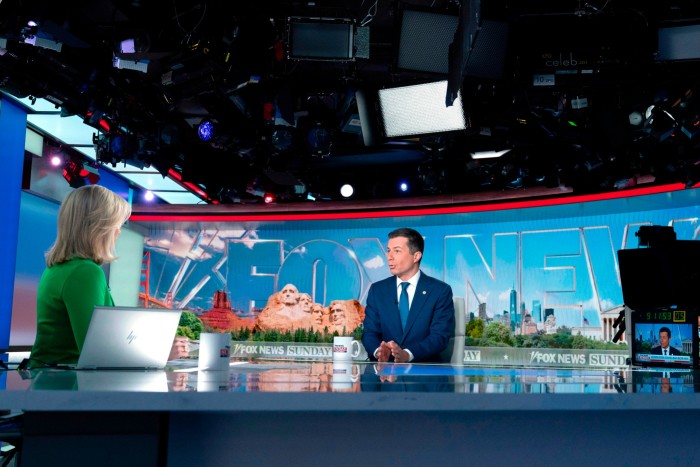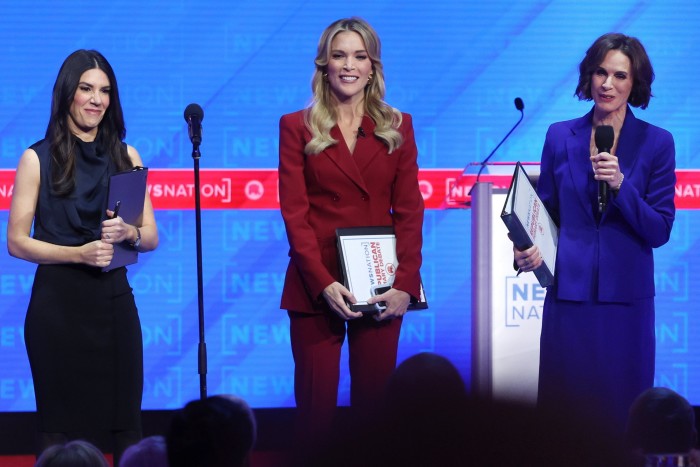Most US election years generate new media stars. In 2008 there was Nate Silver, the statistician who became famous for predicting Barack Obama’s victory. In 2016, Breitbart News shot up from fringe website to global prominence thanks to its close ties with Donald Trump.
This year’s presidential race, however, is testing that truism. Instead, the first “rerun” election match-up in seven decades may be defined by the lack of any one star, network, or set of information.
Audiences are dispersed across a wide range of smaller and medium-sized platforms. News business models are in flux with all corners of the industry, from television to digital to print media, under financial strain. Trust in news organisations continues to fall to all-time lows. Many Americans, sceptical and fatigued, are tuning out of the news entirely.
At a South Carolina polling station in February, Jennifer Koerner, a 51-year-old real estate agent, had just cast her vote for Trump as the Republican nominee for president.
When asked where she gets her news, she rattled off a long list of websites, podcasts, newsletters and influencers — from Julie Kelly, who has spread conspiracy theories about the January 6 2021 attack on the US capitol building, to Tucker Carlson, who launched his own online media outlet after leaving Fox News.
“Independent media for sure, a lot of stuff on Substack, and oh my God, I know, I actually like Tucker Carlson. He is doing good work. Why were people mad at him for interviewing Putin? . . . Substack is a pretty good source, Revolver . . . I love Darren Beattie . . . I think Julie Kelly is doing good work on J6. The Epoch Times does good work, the Gateway Pundit . . . ” she said. “I read way too much news; it is kind of depressing, really.”
She tried not to watch Fox News, she added: “I am pretty pissed at them for their censorship, and there is so much censorship.”
Koerner’s media diet speaks to the splintered, chaotic state of the conservative news ecosystem in 2024.
Among rightwing media, Fox News still leads by a wide margin. The company attracted 85mn visitors to its site in January, trailed in distant second by the Epoch Times, which drew 6mn visitors, according to the website TheRighting.
But traffic to all conservative news websites — as with their counterparts across the political spectrum — has declined sharply compared to the same time in 2020. Fox’s audience was down 24 per cent, TheRighting found, while Breitbart lost 87 per cent and Ben Shapiro’s Daily Wire fell 73 per cent.
Cable television, a stalwart of the US political industrial complex since the 1990s, is in secular decline, resulting in smaller audiences for Fox News and its rivals this election cycle. Facebook, which became the hot centre of conservative politics in 2016 and 2020, has systematically de-prioritised the news. Last month, Meta announced it was removing its dedicated “tab” for news content from its site entirely in the US.
Some Americans are ignoring the news entirely while others are turning to TikTok, Instagram and other non-traditional platforms where influencers often provide a derivative feed of information, posting clips which summarise or discuss reporting from other sources.
“It’s never been [this fragmented],” said Jonathan Miller, a former chief digital officer at Rupert Murdoch’s News Corp. “The younger right-wing audience is all over the place . . . getting [news] from a multitude of places, not television, that includes Substack, TikTok, Instagram and so on.”
Other platforms have popped up specifically to serve conservative audiences, such as video network Rumble, which is financed by Peter Thiel, Trump’s Truth Social and video-sharing site BitChute. According to Pew Research, most of the people who regularly get news from these alternative platforms identified as Republicans, while those who read more established sites identified as Democrats.
These platforms can provide “confirmation bias” for people’s pre-existing beliefs, said Miller, who is now chief executive of Integrated Media, which specialises in digital media investments. “You just want to hear what you want to hear.”

Some rightwing strategists have found a way to weaponise the chaos. This was made clear earlier this year, when the president of Harvard was ousted by what conservative activists touted as an organised campaign against her.
Conservative activist Christopher Rufo said the toppling of Claudine Gay was a “team effort” between himself, the Washington Free Beacon reporter Aaron Sibarium, and others such as billionaire investor Bill Ackman, who repeatedly posted about Gay on social media.
After writing about plagiarism allegations against Gay on Substack on December 10, Rufo amplified the topic on social media through a “substantive campaign of shaming and bullying my colleagues on the left”, he told Politico in January.
Much of the reporting about Gay was published by the Washington Free Beacon, a publication backed by hedge fund billionaire Paul Singer that bills itself as “covering the enemies of freedom the way the mainstream media won’t”.
But with its relatively small reach — The Beacon was the 15th most-visited conservative news website in January — its Harvard reports required louder voices to reach a wider audience.
It was “a textbook example of successful conservative activism . . . How we have to work the media, how we have to exert pressure and how we have to sequence our campaigns in order to be successful”, Rufo said.
One longtime media critic said the conservative news ecosystem “has been democratised to a degree in that anyone can have a Substack”. Several media critics and professors declined to speak on the record for this story, however, for fear of being targeted by activists.
Eliana Johnson, editor of the Free Beacon and a former Fox News producer, said conservative media is “fragmented”, but “what breaks through is new information . . . People are really hungry for new trustworthy sources”.

When asked whether it was a concern that Rufo framed the Beacon’s reporting as part of a political strategy, Johnson declined to comment. “There was no co-ordination between us and Christopher Rufo,” she said: “Chris can speak for himself. Our reporting speaks for itself.”
Substack and podcasts have become landing spots for far-right writers who were banned or restricted by more established social media companies such as Facebook. In a sense, they provide a platform in the same way that Facebook did early on, before it faced scrutiny from lawmakers over Big Tech’s role in spreading false information.
Anthony Nadler, a professor of media and communications at Ursinus College, said: “Going back to the 1990s, there’s always been these rightwing hit jobs . . . a lot of rightwing media operatives were running their own small independent outlets, digging up dirt on [then-president Bill] Clinton. Substack certainly makes it easier and changes the economy of this stuff, [because you] can finance it more.”
Substack’s executives have defended the site’s role as a home to fringe views, in the face of backlash over the presence of neo-Nazis and conspiracy theorists across the site. In a December blog post, co-founder Hamish McKenzie said “we don’t like Nazis either”, but Substack would “stick to our decentralised approach to content moderation”. The platform takes a 10 per cent cut of revenue from newsletter subscriptions.
Podcasting has also become a powerful tool for conservative media stars such as Megyn Kelly and Steve Bannon, whose “War Room” podcast was last year named the top source of misinformation across conservative media, according to a Brookings Institution study.

Over the past year Trump and primary season challengers such as Ron DeSantis have courted rightwing personalities who command large audiences online, such as commentator Jack Posobiec or Chaya Raichik, whose “Libs of TikTok” account on X has 2.9mn followers.
These accounts often gain popularity through a sense of irreverence. Both Trump and Carlson have shared posts by “catturd2”, a social media account run by a man in Florida who was described in a Rolling Stone profile as a “poop-inspired mischief-maker of the Maga movement”.
Nadler is sceptical of how much the landscape has truly changed, pointing to the relatively small audiences of many of these sites or influencers. “A lot of media attention focuses on Gateway Pundit or other rightwing sites that are extremist. But at the same time, it is important to remember that so many folks . . . still mostly watch Fox,” he said.
In the past few months, Trump has increased his appearances on Fox News, the traditional rightwing juggernaut, including a live phone call to the Fox and Friends show in early March — the type of media hit he used to employ frequently as president.
Talk radio, a long-standing fixture of conservative politics, has also endured even after the death in 2021 of Rush Limbaugh, who had been a singular figure in rightwing punditry.
Robyn Copeland, a 68-year-old librarian and Trump supporter from the suburbs of Des Moines, Iowa, said she “used to listen to Rush Limbaugh all the time”.
“Rush educated me so much about Trump’s policies and his business sense and how he thinks everything through and what is good for the country”, she said, speaking from a Trump rally on the eve of the Iowa caucuses in January.
Where does she get her news now? “Every day, after I listen to [Christian broadcaster] Joyce Meyer, to get my teaching on God, then I switch to Steve Bannon, and he analyses what is really going on in the media,” she said. The talk radio banter between Clay Travis and Buck Sexton is also “a wonderful way to learn”.
Such behaviour poses a challenge for politicians, Miller, the former News Corp executive, said: “To reach across it, you have to be all over the place.”









